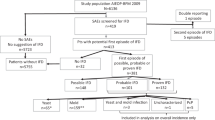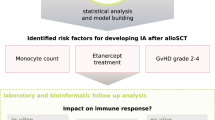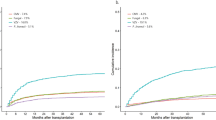Abstract
Several studies have suggested an association of mannose-binding lectin (MBL) deficiency with infections. In this study, we investigated the association between MBL deficiency and invasive fungal disease (IFD) in hematologic malignancy patients receiving myelosuppressive chemotherapy or hematopoietic stem cell transplant. MBL levels were quantified at the start of treatment in 152 patients who were followed for 6 months and scored as developing IFD or not. Forty-five patients (29.6%) developed IFD, of which 21 (46.7% of IFD cases and 13.8% of patients) were proven or probable IFD. Fifty-nine (38.8%) had MBL levels <1000 ng/mL. The rates of all IFD in patients with MBL levels below and above 1000 ng/mL were 33.9% and 26.9%, respectively (P=0.356). The rates of proven or probable IFD in patients with MBL levels below and above 1000 ng/mL were 11.9% and 15.1%, respectively (P=0.579). MBL levels <1000 ng/mL were not predictors of death (P=0.233). As expected, IFD was associated with death (P<0.0001). Our findings indicate that MBL levels <1000 ng/mL were not associated with an increased risk of developing IFD or overall survival.
This is a preview of subscription content, access via your institution
Access options
Subscribe to this journal
Receive 12 print issues and online access
$259.00 per year
only $21.58 per issue
Buy this article
- Purchase on Springer Link
- Instant access to full article PDF
Prices may be subject to local taxes which are calculated during checkout



Similar content being viewed by others
References
Marr KA, Carter RA, Crippa F, Wald A, Corey L . Epidemiology and outcome of mould infections in hematopoietic stem cell transplant recipients. Clin Infect Dis 2002; 34: 909–917.
Pagano L, Caira M, Nosari A, Candoni A, Offidani M, Aloisi T et al. Fungal infections in recipients of hematopoietic stem cell transplants: results of the SEIFEM B-2004 study. Clin Infect Dis 2007; 45: 1161–1170.
Pfaller MA, Pappas PG, Wingard JR . Invasive fungal pathogens: current epidemiological trends. Clin Infect Dis 2006; 43: S3–S14.
Pagano L, Caira M, Candoni A, Offidani M, Fianchi L, Martino B et al. The epidemiology of fungal infections in patients with hematologic malignancies: the SEIFEM-2004 study. Haematologica 2006; 91: 1068–1075.
Bouwman LH, Roep BO, Roos A . Mannose-binding lectin: clinical implications for infection, transplantation, and autoimmunity. Hum Immunol 2006; 67: 247–256.
Fidler KJ, Wilson P, Davies JC, Turner MW, Peters MJ, Klein NJ . Increased incidence and severity of the systemic inflammatory response syndrome in patients deficient in mannose-binding lectin. Intensive Care Med 2004; 30: 1438–1445.
Herpers BL, Endeman H, de Jong BA, de Jongh BM, Grutters JC, Biesma DH et al. Acute-phase responsiveness of mannose binding lectin in community-acquired pneumonia is highly dependent upon MBL2 genotypes. Clin Exp Immunol 2009; 156: 488–494.
Osthoff M, Rovó A, Stern M, Danner D, Gratwohl A, Tichelli A et al. Mannose-binding lectin levels and major infections in a cohort of very long-term survivors after allogeneic stem cell transplantation. Haematologica 2010; 95: 1389–1396.
Neth OW, Bacher U, Das P, Zabelina T, Kabisch H, Kroeger N et al. Influence of mannose-binding lectin genotypes and serostatus in Allo-SCT: analysis of 131 recipients and donors. Bone Marrow Transplant 2010; 45: 13–19.
Anaissie EJ, Zhao W, Wen Y, Grazziutti M, Ling W, Leeet J et al. Deficiency of mannose-binding lectin is a risk factor for invasive pulmonary aspergillosis in patients with multiple myeloma: an analysis of 482 patients. Blood 2008; 112: 249 Abstract 667.
Chaudhry SH, Chaudhry S, Jansen-Hoogendijk AM, Jol van der Zijde CM, van Tol MJ, Roos A et al. Mannose-binding lectin levels and infections in children after allogeneic hematopoietic SCT. Bone Marrow Transplant 2010; 45: 289–293.
Rocha V, Franco RF, Porcher R, Bittencourt H, Silva WA Jr, Latouche A et al. Host defense and inflammatory gene polymorphisms are associated with outcomes after HLA-identical sibling bone marrow transplantation. Blood 2002; 100: 3908–3918.
De Pauw B, Walsh TJ, Donnelly JP, Stevens DA, Edwards JE, Calandra T et al. Revised definition of invasive fungal disease from the EORTC/MSG consensus group. Clin Infect Dis 2008; 46: 1813–1821.
Garred P, Larsen F, Madsen HO, Koch C . Mannose-binding lectin deficiency—revisited. Mol Immunol 2003; 40: 73–84.
Steffensen R, Thiel S, Varming K, Jersild C, Jensenius JC . Detection of structural gene mutations and promoter polymorphisms in the mannan-binding lectin (MBL) gene by polymerase chain reaction with sequence specific primers. J Immunol Methods 2000; 241: 33–42.
Morrell M, Fraser VJ, Kollef MH . Delaying the empiric treatment of Candida blood stream infection until positive blood culture results are obtained: a potential risk factor for hospital mortality. Antimicrob Agents Chemother 2005; 49: 3640–3645.
Greene RE, Schlamm H, Oestmann J-W, Stark P, Durand C, Lortholary O et al. Imaging findings in acute invasive pulmonary aspergillosis: clinical significance of the halo sign. Clin Infect Dis 2007; 44: 373–379.
Riwes MM, Wingard JR . Diagnostic methods for invasive fungal disease in patients with hematologic malignancies. Expert Rev Hematol 2012; 5: 661–669.
Eisen DP, Dean MM, Boermeester MA, Fidler KJ, Gordon AC, Kronborg G et al. Low serum mannose-binding lectin level increases the risk of death due to pneumococcal infection. Clin Infect Dis 2008; 47: 510–516.
Gordon AC, Waheed U, Hansen TK, Hitman GA, Garrard CS, Turner MW et al. Mannose-binding lectin polymorphisms in severe sepsis: relationship to levels, incidence, and outcome. Shock 2006; 25: 88–93.
Neth O, Hann I, Turner MW, Klein NJ . Deficiency of mannose-binding lectin and burden of infection in children with malignancy: a prospective study. Lancet 2001; 358: 614–618.
Garred P, Larsen F, Seyfarth J, Fujita R, Madsen HO . Mannose-binding lectin and its genetic variants. Genes Immun 2006; 7: 85–94.
Gadjeva M, Takahashi K, Thiel S . Mannan binding lectin—a soluble pattern recognition molecule. Mol Immunol 2004; 41: 113–121.
Acknowledgements
This study was sponsored by the University of Florida.
Author information
Authors and Affiliations
Corresponding author
Ethics declarations
Competing interests
The authors declare no conflict of interest.
Rights and permissions
About this article
Cite this article
Riwes, M., Leather, H., Neal, D. et al. Association of mannose-binding lectin levels and invasive fungal disease in hematologic malignancy patients receiving myelosuppressive chemotherapy or allogeneic hematopoietic stem cell transplantation. Bone Marrow Transplant 51, 1228–1232 (2016). https://doi.org/10.1038/bmt.2016.92
Received:
Revised:
Accepted:
Published:
Issue Date:
DOI: https://doi.org/10.1038/bmt.2016.92



